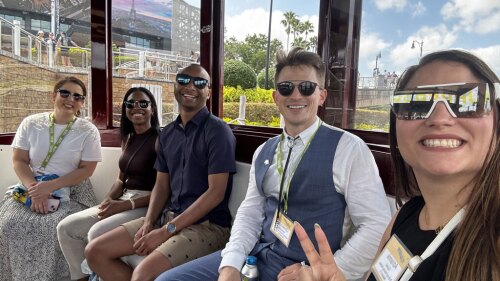Early 1900s styles are reflected inDisney’s Main Street, USA.
Disneyland now boasts more than 60attractions and generates $4.7 billionannually for the local economy. |
Few places speak as magically to the child in all of us as Disneyland, the ULI 1995 Heritage Award winner. “Disneyland was given the Heritage Award by virtue of its timeless quality and character, continuing economic success, and contribution to innovative land use,” jury member James DeFrancia, principal of Lowe Enterprises in Aspen, Colorado, says today of the choice. “All of these attributes were and are reflected in creative and thoughtful mixed use, functional and attractive design, and efficiency.”
The Heritage Award is given to development projects and programs that have established new concepts or standards that have been emulated elsewhere, are of national or international renown, and have been completed for at least 25 years, among other criteria. Given only by unanimous vote of the jury, the honor has been bestowed on only ten projects since the Heritage Award was established 23 years ago.
The “Happiest Place on Earth” has been celebrated for more than just Mickey Mouse and Indiana Jones. Disneyland Park is the flagship of the Disneyland Resort in Anaheim, California. “Disneyland the magic kingdom seems to embody the very structure of myth, employing fables and fairy tales from the depths of American consciousness: tree houses, haunted mansions, mountains, as well as the ideal of a 1950s main street,” Anna Klingmann, founder of New York City–based Klingmann Architects and Brand Consultants, noted in “Architecture as a Product,” a 1999 article published in the Berlin architecture journal Daidalos. “On a deeper level, it manifests the themes of justice, equality and humanity, a reoccurring myth, not only in the animation world of Disney, but in American society at large.”
Walt Disney developed Disneyland Park in just one year between July 1954 and July 1955, aiming to create a major theme park unlike any in the world. Critics said it could not be done; they said people would not come. Even Walt’s brother Roy said, “When Walt brought it up, I listened politely then changed the subject.” On the day Disneyland opened its gates to the 60-acre (24-ha) parcel, there were 18 major attractions and 28,000 guests visited. Today, there are more than 60 attractions, and 450 million guests have passed through the turnstiles.
Disneyland Park now comprises about 500 acres (200 ha) that include Disneyland, its companion park Disney California Adventure, three hotels, and the Downtown Disney business district, says Suzi Brown, director of media relations and external communications for the company. The resort employs 22,000 people, making it the largest employer in Orange County and one of the largest single-site employers in California. The Disney machine supports an additional 57,400 jobs in southern California and generates $4.7 billion annually for the area economy, according to a 2009 independent economic impact study cited by Brown. Disneyland Resort generates $255 million in hotel, sales, property, and income taxes each year, Brown says.
Anaheim had only 18 hotels when the park opened, but the number of hotels and motels multiplied, and residential development followed. Anaheim now has about 150 hotels and motels providing nearly 18,000 rooms, and well over 450 restaurants.
A keystone of Disneyland’s popularity is the holistic real estate approach to the visitor experience. That approach overflows to the surrounding community, as shown by a 2001 national design award from the American Society of Landscape Architects honoring the city and the resort, as well as its landscape architecture firm, SWA Group. The award cited the “comprehensive urban design for the redevelopment of the area surrounding the theme park that visually transforms an aging suburban environment into a garden-like destination resort.”
Anaheim and Orange County are renowned for their crisply manicured streets and Disney-like high-amenity communities. To see Disneyland through an architect’s eyes, read Beth Dunlop’s 1996 book Building a Dream: The Art of Disney Architecture. Said one reviewer, “Even in its early days, the Walt Disney Company pioneered imaginative building styles . . . and commissioned prize-winning architects such as Robert A.M. Stern, Michael Graves, Robert Venturi, Arata Isozaki, Frank Gehry, and Aldo Rossi to create new designs for Disney theme parks worldwide and also for the Disney planned community, Celebration, Florida.” Celebration received a ULI Award for Excellence in 2001.
Leading designers recognize the enduring influence of Disneyland on architecture and real estate. In a video summary of a yearlong design studio at the University of California at Los Angeles that included Disney Imagineering staff, Hitoshi Abi, chair of the UCLA Department of Architecture and Urban Design, said, “Even the Jungle Cruise, my favorite ride, [demonstrates] how you become engaged in the architectural experience.”
Says DeFrancia, “To this day, Disneyland still stands out as being emblematic of quality and character.”







